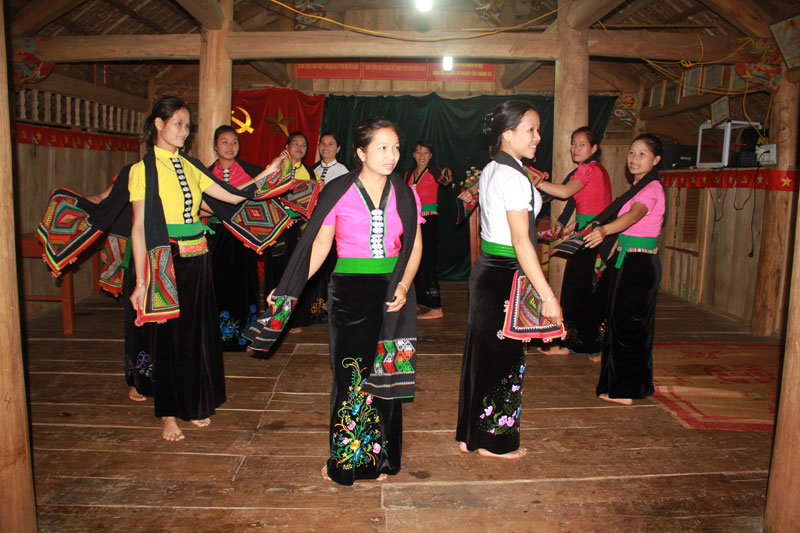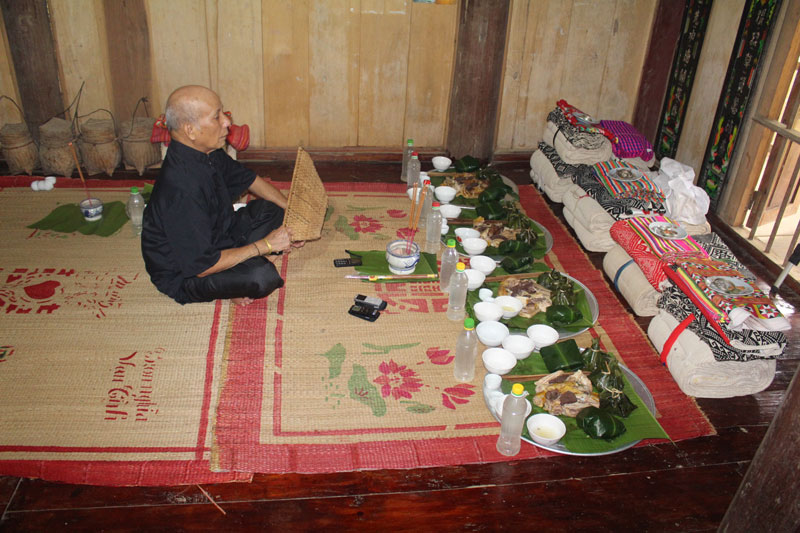
(HBO) – Tay ethnic people account for 40.57 percent of the population in Da Bac district, which is home to five ethnic groups. They reside in the communes of Muong Chieng, Dong Chum, Tan Pheo, Tan Minh and Trung Thanh.
We felt the atmosphere of the National Day when
returning to Muong Chieng, which has the biggest number of
Tayethnics and is described as the "mountainous centre” of Da Bac district. The
National Day September 2 was an occasion for those living far away to reunite
with their families. Sa Van Xuyen, a resident in Na Muoi hamlet, said: "My
family has three children, including two daughters working here and a son
working in
Son La.All of them have their own families. My son, Hung, and his wife have to live
far away because Hung has his own work while his wife is studying at
Tay
Bac
University. Only on the
occasion of major festivals my whole family reunite. My wife and I are waiting
to see them on the upcoming National Day or Independence Festival.”

Xa Van
Bang, a resident in Chieng Can hamlet of Muong Chieng commune (Da Bac), often
hold a ritual called "Lam cham” for his family according to Tay people’s
traditional custom after the Independence Festival celebration.
Bidding farewell to Xuyen, we came to Chieng Can
commune to visit Xa Van Hoi, who was a driver in the southern battlefield for
13 years (from 1970 to 1983). Recalling wartime memories, Hoi said: "The 13
years I was a driver at Unit 670 of Regiment 19 were also 13 times I spent the National
Day with my comrades and witnessed both pains and victories in the war. I still
remember the feeling of concurrently celebrating Tet (the traditional New Year
festival), standing guard and being ready to fight. It was not rare that I saw
my comrades were killed by the enemy’s bullets and bombs. Those pains nurtured
our undaunted and unyielding will, helping us fight for national independence.”
The team
of Na Man hamlet, Muong Chieng commune (Da Bac), rehearses a singing and
dancing performance imbued with the
Tayculture before the celebration of the National Day September 2.
His children usually come home twice a year, on
the National Day (September 2) and the Lunar New Year. Hoi said: "Whenever the
Independence Festival comes, I’m eager for my children to come back to reunite
with the family. To me, seeing my children gradually growing up each time we
gather is the most joyful festival.”
Singing and dancing performances and sports
activities like volleyball and football matches between hamlets, and communes
on the occasion of the Independence Festival were always magnets for local
residents.
We also witnessed
Tayethnic girls’ dedication to a rehearsal before their public performance marking
the National Day in Na Man hamlet of Muong Chieng commune. Xa Thi Thay, who led
the hamlet’s performing team, said they were rehearsing a "xoe” dance which
would be performed together with other teams in the commune. We chose this
dance since it was deeply imbued with the
Tayethnic group’s cultural identities, showing the community’s solidarity and
love.
Aside from entertainment activities, the "Lam
cham” ritual of
Tay people was also practiced
by many families in the Independence Festival. Xa Van Bang, a resident in
Chieng Can commune, said the ritual was often organised in the eighth or ninth
lunar months, but now some families hold this ritual on the September 2
occasion, when their whole families reunited.
More than just an information technology teacher, Bui Van Nien is an inspiring figure who has nurtured the scientific curiosity and creative spirit of students in Vietnam’s ethnic minority communities.
Da Bac is the most disadvantaged mountainous district in Hoa Binh province, with ethnic minorities accounting for about 90% of its population. Over the past years, the district has mobilised resources to implement ethnic policies to improve the quality of life of local people.
In recent years, Hoa Binh province has consistently prioritised the protection, care, and education of children, particularly those from ethnic minorities and disadvantaged backgrounds, by creating a safe, healthy, and nurturing environment for their all-round development.
The Steering Committee for Tobacco Harm Prevention and Control of Hoa Binh province, in coordination with the Tobacco Harm Prevention and Control Fund, held a ceremony on May 28 in response to the World No Tobacco Day (May 31) and the National No Tobacco Week (from May 25 to 31). The event was chaired by Nguyen Van Toan, Standing Vice Chairman of the provincial People’s Committee and head of the Steering Committee.
Since 2021, the Center for Industrial Promotion and Industrial Development Consulting (CIIDC) under the Department of Industry and Trade has been implementing a school lighting model as part of the plan for using energy efficiently and economically in Hoa Binh Province in the pẻiod of 2021 - 2025. This model not only aims to improve the learning conditions and enhance the education quality, but it also promotes the message of energy saving, energy security, environmental protection and contributes to the goals of socio-economic development.
In the 2024 - 2025 school year, the entire Hoa Binh provincial education sector includes 520 educational institutions and schools. Among them are 13 ethnic boarding schools with 153 classes and 4,487 students. Four of these schools have met national standards, reaching 30.7 percent.




